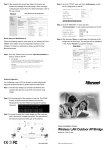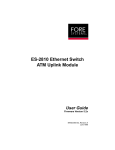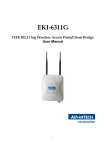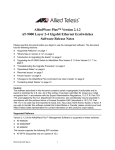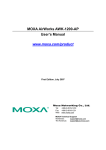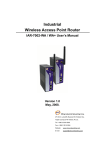Download MicroNet SP915A User`s manual
Transcript
User’s Manual Wireless LAN Outdoor AP/Bridge Model No.: SP915-1000 World Wide Web: www.micronet.com.tw ; www.micronet.info Table of Contents Chapter 1 Introduction................................................................................... 1 1.1 Package Contents .......................................................................................... 1 1.2 Key Features ................................................................................................. 1 1.3 LED Indicator ............................................................................................... 2 Chapter 2 Installation and Configuration ....................................................... 3 2.1 Mounting the SP915-1000 ............................................................................ 3 2.2 Connecting the Managing PC and the SP915............................................... 5 2.3 Preparing for Configuration.......................................................................... 5 2.4 Accessing Web-based User Interface ........................................................... 7 2.5 Quick Setup via Web-Based UI.................................................................... 8 2.5.1 Operational Mode..............................................................................................8 2.5.2 IP Address ........................................................................................................10 2.5.3 Wireless Settings.............................................................................................10 2.5.4 Restart Device .................................................................................................10 2.6 Installation................................................................................................... 11 2.7 Setting up Client Computers....................................................................... 13 2.7.1 Configuring SP915-1000 Related Settings .................................................13 Chapter 3 Web-Based Management........................................................... 14 3.1 Overview..................................................................................................... 14 3.2 Menu Structure............................................................................................ 14 3.2.1 Save, Save & Restart, and Cancel ...............................................................15 3.2.2 Home and Refresh ..........................................................................................16 3.3 Status Menu ................................................................................................ 17 3.3.1 Wireless Clients ...............................................................................................17 3.3.2 DHCP Mappings..............................................................................................17 3.3.3 System Log ......................................................................................................18 3.3.4 Link Monitor......................................................................................................18 3.4 General Operation....................................................................................... 19 3.4.1 Operational Mode............................................................................................19 3.4.2 Changing Password........................................................................................20 3.4.3 Managing Firmware ........................................................................................20 3.5 TCP/IP Related Settings ............................................................................. 24 3.5.1 Addressing........................................................................................................24 3.5.2 Static DHCP Mappings...................................................................................24 3.6 IEEE 802.11 Menu...................................................................................... 25 3.6.1 Communication................................................................................................25 3.6.2 Security .............................................................................................................28 3.6.3 IEEE 802.1x/RADIUS .....................................................................................33 3.7 Configuring Advanced Settings.................................................................. 35 3.7.1 Packet Filters ...................................................................................................35 3.7.2 Management ....................................................................................................37 Chapter 4 Appendix..................................................................................... 40 4.1 Appendix A: Default Settings..................................................................... 40 4.2 Appendix B: Troubleshooting .................................................................... 41 4.2.1 Wireless Settings Problems...........................................................................41 4.2.2 TCP/IP Settings Problems .............................................................................42 4.3 Appendix C: Additional Information.......................................................... 44 4.3.1 Distances and Data Rates .............................................................................44 4.3.2 Specification .....................................................................................................45 Chapter 1 Introduction Micronet proudly introduces SP915-1000, high power outdoor Access Point. It is compliant with IEEE802.11b providing speed of up to 11Mbps. The AP includes a Web-Based User Interface for easy management of your wireless network. Security is intact with WEP, WPA and 802.1x for preventing unauthorized access in wireless environment. SP915-1000 combining with high power antenna (SP920MA-12) is ideal for distant inter-building connection. 1.1 Package Contents Prior to the installation of the device, please verify the following items are in the package: y y y y y y y y 1.2 y SP915-1000 Wireless LAN Outdoor AP/Bridge Quick Installation Guide Manual CD 1.2M 10/100Base-T/TX Ethernet Cable 25M Waterproof 10/100Base-T/TX Ethernet Cable Wall-Mounting Kit AC Power Cord Power Injector Key Features Operational modes ¾ AP/Bridge provides both Access Point and Static LAN-to-LAN Bridging functionality. The static LAN-to-LAN bridging function is supported through Wireless Distribution System (WDS) 1 y y y y y y y y y y y y y 1.3 ¾ AP Client is for Dynamic LAN-to-LAN Bridging. The AP Client automatically establishes bridge links with APs from any vendors. Enabling/disabling SSID broadcasts. MAC-address-based access control. Antenna alignment assistance. Link health monitoring. Wireless client isolation. AP load balancing. Transmit power control. Association control can be configured to deny association requests when it has served too many wireless clients or traffic load is too heavy (AP/Bridge) DHCP Server/Client including static DHCP mappings. Provides Layer 2, Layer 3, and Layer 4 filtering capabilities. System Log: local log and remote log by SNMP. Supplying power to an AP over an Ethernet cable using PoE. Restarts hardware when firmware failure is detected. LED Indicator There are several LED indicators inside the housing of the SP915-1000. They are defined as follows: y y y y ALV: Alive. Blinks when the AP is working normally. RF: SP915-1000 interfaces activity LAN: Ethernet LAN interface activity PWR: Power 2 Chapter 2 Installation and Configuration 2.1 Mounting the SP915-1000 Follow steps below to mount SP915-1000 with a wall-mount kit #1. 1. Put the M6*90 screw into wall mount #1. 2. Fix the wall mount #1 to the bottom of SP915-1000 by using M4*80 screw. 3. Fix the SP915-1000 to the pole with the wall mount #1 using M6*90 screw. 4. Use M6 screw set, including spring washer and nuts, to finish the installation. 3 Follow steps below to mount SP915-1000 with a wall-mount kit #2. 1. Stick the supplied sticker for wall mount #2. 2. Use the 7.00mm driller to drill a 25mm-deep hole at each of the cross marks. 3. Plug in a supplied plastic conical anchor in each hole. 4. Screw a supplied ST3.9*20 screw in each plastic conical anchor for a proper depth so that the wireless AP can be hung on the screws. 5. Fix two wall mounts #1 to the bottom of SP915-1000 by using two M4*80 screws. 6. After fix wall mount #1 and #2, please see the diagram to align wall mount #1 and #2. 7. Fix the wall mount #1 and #2 together using M4*80 screw to complete installation. 4 2.2 Connecting the Managing PC and the SP915 To connect the Ethernet managing computer and the managed AP for firsttime configuration, users have two choices as illustrated in diagram below. (Note: One connector of the Ethernet cable must be plugged into the LAN/CONFIG Ethernet jack of the SP915-1000 for configuration.) 2.3 Preparing for Configuration For users to configure the SP915-1000, a managing computer with a Web browser is needed. For first-time configuration of an SP915-1000, an Ethernet network interface card (NIC) should have been installed in the managing computer. For maintenance-configuration of a deployed SP915-1000, either a wireless computer or a wired computer can be employed as the managing computer. (Note: If users are using the browser, Opera, to configure an AP, click the menu item <File>, click <Preferences...>, click <File types>, and <edit> the <MIME> type, <text/html>, to add a file extension “.sht” so that Opera can work properly with the Web management pages of the AP.) 5 PC/Notebook must belong in the same IP range and subnet. Follow the steps below to configure IP settings for LAN PC. Step 1. In the control panel, double click on Network Connections. Double click on the local area connection (e.g. LAN). The following screen will appear. Step 2. Select ‘Internet Protocol (TCP/IP)’, and then click on the ‘Properties’ button. The screen will appear to allow entry of TCP/IP settings. Step 3. Select ‘Use the following IP Address’ button and then enter the IP address and subnet mask. Ensure the IP address and subnet mask are on the same subnet as the Access Point. Click on ‘OK’ button to save the setting. 6 2.4 IP Address 192.168.0.1 Subnet Mask 255.255.255.0 Username root Password root Accessing Web-based User Interface SP915-1000 is embedded with web-based management user interface and provides a series of web pages, which display the configuration and status of the system. After configuration of IP, the management interface can be access by entering the IP address of the router into the browser. Step 1. Login page will appear to prompt users to enter the username and password. Step 2. After entering the correct login detail, the browser will forward the webpage to the setup page. Users can begin configuring the Access Point. For detail information, refer to the user manual. 7 2.5 Quick Setup via Web-Based UI Follow the following steps for quick setup of your wireless AP. Click <Save> at the bottom of each configuration interface to save changes. 2.5.1 Operational Mode Go to the ‘General’ menu and click <Operational Mode> to select a mode for the AP. The AP supports 2 operational modes: y AP/Bridge: This mode provides both Access Point and Static LAN-toLAN Bridging functionality. The static LAN-to-LAN bridging function is supported through Wireless Distribution System (WDS). 8 y AP Client: This mode is for Dynamic LAN-to-LAN Bridging. The AP Client automatically establishes bridge links with APs from any vendors. In either mode, the AP forwards packets between its Ethernet interface and wireless interface for wired hosts on the Ethernet side and wireless host(s) on the wireless side. There are 2 types of wireless links as specified by the IEEE 802.11 standard. y STA-AP: This type of wireless link is established between an IEEE 802.11 Station (STA) and an IEEE 802.11 Access Point (AP). An STA is usually a client computer (PC or PDA) with a WLAN network interface card (NIC). The AP Client mode is actually an STA. y WDS: This type of wireless link is established between two IEEE 802.11 APs. Wireless packets transmitted along the WDS link comply with the IEEE 802.11 WDS (Wireless Distribution System) format at the link layer. The relationships among the operational modes and the wireless link types are shown in the following table: AP/Bridge AP Client AP/Bridge WDS STA-AP AP Client STA-AP To establish a static bridge link based on WDS, the AP/bridges at both end of the WDS link must be manually configured with each other’s MAC addresses. To establish a dynamic bridge link between an AP and an AP Client, both devices have to be configured with the same SSID and WEP settings. The AP Client automatically scans for any AP that is using the matched SSID and establishes a bridge link with the scanned AP. 9 2.5.2 IP Address Go to the ‘TCP/IP’ menu and click <Addressing> to alter the IP configuration for the AP. 2.5.3 Wireless Settings Go to the ‘IEEE 802.11’ menu and click <Communication> to set wireless parameters for the AP. 2.5.4 Restart Device After pressing <Save> on each page, the interface will be bought back to Start Page. The changes will be highlighted in red. Press <Restart> to apply the changes. 10 2.6 Installation For configuring a pair of APs for dynamic or static bridging with high grain directional antenna, please follow the steps below. Step 1. Connect each bridge to a computer via Ethernet and configure the data rate of each AP to the lowest value, 1Mbps. Step 2. Fix the alignment of the antenna on one side. Run ‘PING’ function in DOS environment between the two APs. Response time from the ‘PING’ will indicate the optimal alignment. Step 3. Increase the data rate of both bridges until the maximum limit is reached for a stable connection. The data rate will be limited by distance and the gain of the antenna. 11 (Note: When doing dynamic bridging, configure Bridge 1 to be in AP Client mode and configure Bridge 2 to be in AP/Bridge mode. If users are doing static bridging, make use of the Antenna Alignment Assistance feature to help align the directional antennas.) Instead of using PING.exe, users can run Wireless Network Manager on Computer 1, and go to the Antenna Alignment tab. Click <Start> to begin monitoring the WDS link quality. Adjust the alignment of the antenna of Bridge 1 until the Link quality indicator shows a relatively maximal value. Finally, click <Stop> to stop monitoring WDS link quality. If users are 12 installing dynamic bridging, use the Link Monitor feature on the AP Client side to help align the directional antennas. 2.7 Setting up Client Computers The TCP/IP and IEEE 802.11b-related settings of wireless client computers must match those of the AP. 2.7.1 Configuring SP915-1000 Related Settings Before the TCP/IP networking system of a wireless client computer can communicate with other hosts, the underlying wireless link must be established between this wireless computer and an AP. To establish wireless link to the AP: y Launch the configuration/monitoring utility provided by the vendor of the installed WLAN NIC. y Use the utility to make appropriate Operating Mode, SSID and WEP settings. y A wireless client computer must be in infrastructure mode, so that it can associate with an AP. y The SSID of the wireless client computer and the SSID of the AP must be identical. Or, in case the SSID broadcasts capability of the AP is enabled (by default), the SSID of the wireless client computer could be set to “any”. y Both the wireless client computer and the AP must have the same WEP settings for them to communicate with each other. 13 Chapter 3 Web-Based Management The following chapter will outline the web-based user interface used for configuring SP915-1000. 3.1 Overview Once, the login details are correctly entered, the web browser will proceed to the following page containing overview of AP’s settings. 3.2 Menu Structure The left side of the start page contains a menu for users to carry out commands. Here is a brief description of the hyperlinks on the menu. y Home: For returning back to the start page. y Status: Status information. ¾ Wireless Clients: The status of the wireless clients currently associated with the AP. 14 y y y y ¾ DHCP Mappings: Current IP-MAC Address mappings of the builtin DHCP server. ¾ System Log: System events log. ¾ Link Monitor: When the AP is in AP Client mode, this page shows the signal strength and link quality of the wireless link to its associated access point. General: General tools. ¾ Password: For gaining rights to change the settings of the AP. ¾ Firmware Tools: For upgrading the firmware of the AP, backing up and restoring configuration, and configuration reset settings of the AP. TCP/IP: TCP/IP related settings. ¾ Addressing: IP address settings for the AP to work with TCP/IP. ¾ DHCP Server: Settings for the DHCP (Dynamic Host Configuration Protocol) server on the AP. IEEE 802.11: IEEE 802.11b-related settings. ¾ Communication: Basic settings for the IEEE 802.11b interface of the AP to work properly with wireless clients. ¾ Security: Security settings for authenticating wireless users and encrypting wireless data. ¾ IEEE 802.1x/RADIUS: IEEE 802.1x Port-Based Network Access Control and RADIUS (Remote Authentication Dial-In User Service) settings for better wireless security. Advanced: Advanced settings of the AP. ¾ Packet Filters: Ethernet Type Filters, IP Protocol Filters, and TCP/UDP Port Filters settings. ¾ Management: UPnP, System Log, and SNMP settings. 3.2.1 Save, Save & Restart, and Cancel At the bottom of each page contains the following buttons: <Save>, <Save & Restart>, and <Cancel>. Clicking <Save> stores the settings changes to the memory of the AP and brings users back to the start page. Clicking <Save & Restart> stores the settings changes to the memory of the AP and restarts 15 the AP immediately for the settings changes to take effect. Clicking <Cancel> discards any settings changes and brings users back to the start page. If users click <Save>, the start page will reflect the changed settings and followed by two buttons: <Restart> and <Cancel>. In addition, changes are highlighted in red. Clicking Cancel discards all the changes. Clicking Restart restarts the AP for the settings changes to take effect. 3.2.2 Home and Refresh At the bottom of each status page that shows read-only information, there are two buttons: <Home> and <Refresh>. Clicking <Home> brings user back to the start page. Clicking <Refresh> updates the status information. 16 3.3 Status Menu 3.3.1 Wireless Clients On this page, the status information of each associated client, including its MAC address, IP address, user name (if the client has been IEEE 802.1x authenticated), number of bytes it has send, number of bytes it has received, and the time of its last activity, are shown. 3.3.2 DHCP Mappings On this page, all the current static or dynamic DHCP mappings are shown. A DHCP mapping is a correspondence relationship between an IP address assigned by the DHCP server and a computer or device that obtains the IP address. A computer or device that acts as a DHCP client is identified by its MAC address. A static mapping indicates that the DHCP client always obtains the specified IP address from the DHCP server. You can set static DHCP mappings in the Static DHCP Mappings section of the DHCP Server configuration page. A 17 dynamic mapping indicates that the DHCP server chooses an IP address from the IP address pool specified by the First allocatable IP address and Allocatable IP address count settings on the DHCP Server configuration page. 3.3.3 System Log System events are recorded in the memory of the AP. The logged information is useful for troubleshooting purposes. The system events are divided into several categories, and users can select which categories of events to log. 3.3.4 Link Monitor When the SP915 is in AP Client mode, users can use the Link Monitor status page to monitor the link quality and signal strength sensed by its RF module. Larger values mean better wireless connectivity to its associated Access Point. This feature is especially useful for aligning a pair of directional antennas for bridging applications. (Note: Values update every 20 seconds.) 18 3.4 General Operation 3.4.1 Operational Mode The AP supports 2 operational modes: y AP/Bridge: This mode provides both Access Point and Static LAN-toLAN Bridging functionality. The static LAN-to-LAN bridging function is supported through Wireless Distribution System (WDS). y AP Client: This mode is for Dynamic LAN-to-LAN Bridging. The AP Client automatically establishes bridge links with APs from any vendors. In either mode, the AP forwards packets between its Ethernet interface and wireless interface for wired hosts on the Ethernet side and wireless host(s) on the wireless side. There are 2 types of wireless links as specified by the IEEE 802.11 standard. y STA-AP: This type of wireless link is established between an IEEE 802.11 Station (STA) and an IEEE 802.11 Access Point (AP). An STA is usually a client computer (PC or PDA) with a WLAN network interface card (NIC). The AP Client mode is actually an STA. y WDS: This type of wireless link is established between two IEEE 802.11 APs. Wireless packets transmitted along the WDS link comply with the IEEE 802.11 WDS (Wireless Distribution System) format at the link layer. The relationships among the operational modes and the wireless link types are shown in the following table: 19 AP/Bridge AP Client AP/Bridge WDS STA-AP AP Client STA-AP To establish a static bridge link based on WDS, the AP/bridges at both end of the WDS link must be manually configured with each other’s MAC addresses. To establish a dynamic bridge link between an AP and an AP Client, both devices have to be configured with the same SSID and WEP settings. The AP Client automatically scans for any AP that is using the matched SSID and establishes a bridge link with the scanned AP. (Note: Although it’s more convenient to use dynamic bridging, it has a limitation. The AP Client only can forward TCP/IP packets between its wireless interface and Ethernet interface and other type of traffic (such as IPX and AppleTalk) is not forwarded.) 3.4.2 Changing Password On this page, users can change the user name and password for the right to modify the configuration of the bridge. The new password must be typed twice for confirmation. 3.4.3 Managing Firmware Firmware management operations for the SP915 include firmware upgrade, configuration backup, configuration restore, and configuration reset. Firmware upgrade, configuration backup, and configuration restore can be achieved via HTTP or TFTP. The HTTP-based way is suggested because it’s more user- 20 friendly. However, due to different behavior of different Web browser types and versions, HTTP-based firmware management operations may not work properly with some Web browsers. If users cannot successfully perform HTTP-based firmware management operations with the Web browser, try the TFTP-based method. Upgrade Firmware via HTTP y Click <Browse> and then select a correct firmware .bin file. The firmware file path will be shown in the Firmware file name text box. y Click <Upgrade> to begin the upgrade process. Backing up and Restoring Configuration Settings via HTTP y Click <Back Up>. y Users will be prompted to open or save the configuration file. Click <Save>. y The configuration file is named by the AP’s MAC address. For example, if the AP’s MAC address is 00-01-02-33-44-55, the configuration backup file should be “000102334455.hex”. Don’t change the configuration file name in the Save As dialog box. Select a folder in which the configuration file is to be stored, then click <Save>. To Restore Configuration via HTTP y Click <Browse> and then select a correct configuration .hex file. Make sure the file name is the AP’s MAC address. The firmware file path will be shown in the Firmware file name text box. y Click <Restore> to upload the configuration file to the AP. 21 Upgrading Firmware via TFTP When use TFTP as the firmware management protocol, users can configure settings for the AP’s TFTP client to communicate with a TFTP server. If the TFTP client does not get a response from the TFTP server within a period specified by the Timeout setting, it will resend the previous request. The Max number of retries setting specifies the maximal number of resend before the TFTP client stops communicating with the TFTP server. y y y y y y y y Get a computer that will be used as a TFTP server and as a managing computer to trigger the upgrade process. Connect the computer and one of the LAN Ethernet switch port with a normal Ethernet cable. Configure IP address of the computer so that the AP and the computer are in the same IP subnet. On the computer, run the TFTP Server utility. And specify the folder in which the firmware files reside. On the computer, run a Web browser and click the General, Firmware Tools hyperlink. Choose TFTP as the Firmware management protocol. Specify the IP address of the computer, which acts as a TFTP server. If users don’t know the IP address of the computer, open a Command Prompt, and type IpConfig, then press the <Enter> key. Trigger the firmware upgrade process by clicking Upgrade. Backing up Settings by TFTP y Get a computer that will be used as a TFTP server and as a managing computer to trigger the backup process. y Connect the computer and one of the LAN Ethernet switch port with a normal Ethernet cable. y Configure the IP address of the computer so that the computer and the AP are in the same IP subnet. 22 y y y y y On the computer, run the TFTP Server utility. Select the Accept write requests check box, and specify the folder to which the configuration settings of the AP will be saved. On the computer, run a Web browser and click the <General>, <Firmware Tools> hyperlink. Choose TFTP as the Firmware management protocol. Within the Configuration Backup/Restore section, specify the IP address of the computer, which acts as a TFTP server. If users don’t know the IP address of the computer, open a Command Prompt, and type IpConfig, then press the <Enter> key. Trigger the backup process by clicking <Back Up>. The AP’s configuration settings will be saved as “AaBbCcDdEeFf.hex” by the TFTP server, where “AaBbCcDdEeFf” is the AP’s MAC address. For example, if the AP’s MAC address is 00-01-02-33-44-55, the configuration backup file will be “000102334455.hex”. To Restore Configuration via TFTP y Get a computer that will be used as a TFTP server and as a managing computer to trigger the restoring process. y Connect the computer and one of the LAN Ethernet switch port with a normal Ethernet cable. y Configure the IP address of the computer so that the computer and the AP are in the same IP subnet. y On the computer, run the TFTP Server utility. Specify the folder in which the configuration backup file resides. A configuration backup file is named by the AP’s MAC address. For example, if the AP’s MAC address is 00-01-02-33-44-55, the configuration backup file should be “000102334455.hex”. y On the computer, run a Web browser and click the <General>, <Firmware Tools> hyperlink. y Choose TFTP as the Firmware management protocol. y Within the Configuration Backup/Restore section, specify the IP address of the computer, which acts as a TFTP server. If users don’t know the IP address of the computer, open a Command Prompt, and type IpConfig, then press the <Enter> key. 23 y Trigger the restoring process by clicking <Restore>. The AP will then download the configuration backup file from the TFTP server. Resetting Configuration to Factory Defaults Clicking the <Reset> button resets the device configuration to factory defaults. 3.5 TCP/IP Related Settings 3.5.1 Addressing The IP address of the AP can be manually set (Set Manually) or automatically assigned by a DHCP server on the LAN (Obtain from a DHCP Server). If users are manually setting the IP address, Subnet mask, and Default gateway settings, set them appropriately, so that they comply with your LAN environment. In addition, users can specify the Host name and Domain (DNS suffix) of the AP. 3.5.2 Static DHCP Mappings IP addresses of servers are often static so that clients could always locate the servers by the static IP addresses. By Static DHCP Mappings, users can ensure that a host will get the same IP address when it requests one from the DHCP server. Therefore, instead of configuring the IP address of an intranet 24 server manually, you can configure the server to obtain an IP address by DHCP and it is always assigned the same IP address. y y 3.6 Specify the MAC address of the DHCP client and the IP address to be assigned. Then, give a description for this mapping. Select the corresponding Enabled check box. IEEE 802.11 Menu 3.6.1 Communication 3.6.1.1 Basic Basic communication settings include AP functionality, Regulatory domain, Channel number, Network name (SSID), Data rate, and Transmit power. y For specific needs such as configuring the AP as a wireless LAN-toLAN bridge, the AP functionality can be disabled, so that no wireless 25 y y y y client can associate with the AP. The number of available RF channels depends on local regulations. Therefore users have to choose an appropriate regulatory domain to comply with local regulations. The SSID of a wireless client computer and the SSID of the AP must be identical for them to communicate with each other. If there is RF interference, users may want to reduce the Data rate for more reliable wireless transmission. In most cases, leave the setting to ‘Auto’. The transmit power of the RF module of the AP can be adjusted so that the RF coverage of the AP can be changed. 3.6.1.2 Link Integrity When the Ethernet LAN interface is detected to be disconnected from the wired network, all currently associated wireless clients are disassociated by the AP and no wireless client can associate with the AP. The detection mechanism is based on ‘Ping’, the IP address specified in Reference host. 3.6.1.3 Association Control If the number of currently associated wireless clients exceeds the value specified in the ‘Max number of clients setting’, no more wireless client can associate with the AP. If traffic load of the AP exceeds the load specified in the ‘Block clients if traffic load exceeds setting’, no more wireless client can associate with the AP. 26 3.6.1.4 AP Load Balancing Several APs can form a load-balancing group if they are set with the same ‘Group ID’. The load-balancing policy can be by ‘Number of Users’ or by ‘Traffic Load’. If the ‘Number-of-Users’ policy is selected, a new wireless user can only associate with an AP that has the smallest number of associated wireless users in the group. On the other hand, if the ‘Traffic-load Policy’ is selected, a new wireless user can only associate with an AP that has the less traffic load in the group. 3.6.1.5 Wireless Distribution System Traditionally, access points are connected by Ethernet. By Wireless Distribution System (WDS), APs can communicate with one another wirelessly. For example, in the below diagram, AP 2 acts as an access point for the notebook computers and it forwards packets sent from the notebook computers to AP 1 through WDS. Then, AP 1 forwards the packets to the Ethernet LAN. Packets destined for the notebook computers follow a reverse path from the Ethernet LAN through the APs to the notebook computers. In this way, AP 2 plays a role of “AP repeater”. 27 By WDS, two or more LAN segments can be connected wirelessly. As illustrated in the below diagram, a pair of wireless LAN-to-LAN bridges is used to connect two LAN segments. Since the AP is WDS-enabled, it can be used as a wireless bridge. y y Specify the MAC address of the AP at the other end of the WDS link. Select the corresponding Enabled check box. (Note: An AP can have up to 6 WDS links to other APs or wireless bridges.) 3.6.2 Security Security settings include SSID broadcasts, Wireless client isolation, Security mode, IEEE 802.11 Authentication algorithm, WEP keys, MAC-AddressBased Access Control. 3.6.2.1 Basic Security Setting For security reasons, it’s highly recommended that the security mode be set to options other than Open System. When the security mode is set to Open System, no authentication and data encryption will be performed. Additionally, you can disable the SSID broadcasts functionality so that a wireless client computer with an “any” SSID cannot associate with the AP. 28 When the Wireless client isolation setting is set to ‘This AP Only’, wireless clients of this AP cannot see each other, and wireless-to-wireless traffic is blocked. When the setting is set to ‘All APs in This Subnet’, traffic among wireless users of different APs in the same IP subnet is blocked. This feature is useful for WLANs deployed in public places. In this way, hackers have no chance to attack other wireless users in a hotspot. When the Wireless client isolation setting is set to ‘This AP Only’, wireless clients (STAs) of this AP cannot see each other, and wireless-to-wireless traffic between the STAs is blocked. When the setting is set to ‘All APs in This Subnet’, traffic among wireless users of different APs in the same IP subnet is blocked. The behaviors are illustrated in the following figures. STA 1 STA 3 STA 2 AP 1 AP 2 WCI: This AP Only WCI: This AP Only Switch Wireless Link Ethernet Link Behavior of the “This AP Only” wireless client isolation option. 29 STA 1 STA 3 STA 2 AP 1 AP 2 WCI: All APs in This Subnet WCI: All APs in This Subnet Switch Wireless Link Ethernet Link Behavior of the “All APs on This Subnet” wireless client isolation option. As illustrated in the first figure when AP 1 and AP 2 are using the “This AP Only” option, wireless traffic between STA 1 and STA 2 is blocked by AP 1. While wireless traffic between STA 2 and STA 3, which are associated with different APs, is still allowed. If the “All APs in This Subnet” option is used as shown in second figure, AP 1 and AP 2 communicates with each other via an inter-AP protocol to share their STA association information to block wireless traffic among all the STAs. There are up to 7 security modes depending on AP model variations: y Open System: No authentication, no data encryption. y Static WEP: WEP (Wired Equivalent Privacy) keys must be manually configured. y Static TKIP (WPA-PSK): Only TKIP (Temporal Key Integrity Protocol) mechanism of WPA (Wi-Fi Protected Access) is enabled. In this mode, users have to specify the Pre-shared key, which will be used by the TKIP engine as a master key to generate keys that actually encrypt outgoing y IEEE 802.1x EAP without Encryption (EAP-MD5): The IEEE 802.1x functionality is enabled and the user-name/password-based EAPMD5 authentication is used. No data encryption. 30 y y y IEEE 802.1x EAP with Static WEP (EAP-MD5): The IEEE 802.1x functionality is enabled and the user-name/password-based EAPMD5 authentication is used. Data encryption is achieved by static WEP. IEEE 802.1x EAP with Dynamic WEP (EAP-TLS, EAP-TTLS, PEAP): The IEEE 802.1x functionality is enabled and dynamic WEP key distribution authentication (EAP-TLS, EAP-TTLS, or PEAP) is used. Data encryption is achieved by dynamic WEP. IEEE 802.1x EAP with Dynamic TKIP (WPA): This is a full WPA mode, in which both the TKIP and IEEE 802.1x dynamic key exchange mechanisms are enabled. The AP is highly secured in this mode. In the above security modes, a back-end RADIUS (Remote Authentication Dial-In User Service) server is needed if IEEE 802.1x functionality is enabled. According to the IEEE 802.11 standard, WEP can be used for authentication and data encryption. Normally, Shared Key authentication is used if WEP data encryption is enabled. In rare cases, Open System authentication may be used when WEP data encryption is enabled. The Authentication algorithm setting is provided for better compatibility with wireless clients with various WLAN network adapters. There are three options available, including Open System, Shared Key, and Auto. When WEP is enabled by a security mode, the Key length can be specified to be 64 Bits or 128 Bits. The Selected key setting specifies the key to be used as a send-key for encrypting traffic from the AP side to the wireless client side. All 4 WEP keys are used as receive-keys to decrypt traffic from the wireless client side to the AP side. 3.6.2.2 MAC-Address-Based Access Control With MAC-Address-Based Access Control, users can specify the wireless client computers that are permitted or not permitted to associate with the AP. When the table type is set to inclusive, entries in the table are permitted to associate with the AP. When the table type is set to exclusive, entries in the table are not permitted to associate with the AP. 31 With MAC-Address-Based Access Control, users can specify the wireless client computers that are permitted or not permitted to associate with the AP. When the table type is set to inclusive, entries in the table are permitted to associate with the AP. When the table type is set to exclusive, entries in the table are not permitted to associate with the AP. For denying access to the wireless network, please follow the below procedure: 1. Select ‘Enabled’ from the Functionality drop-down list. 2. Set the Access control type to ‘exclusive’. 3. Specify the MAC address of a wireless client to be denied access, and then click <Add>. 4. Repeat Steps 3 for other wireless clients. For granting access to wireless network, please follow the below procedure: 1. Select ‘Enabled’ from the Functionality drop-down list. 2. Set the Access control type to ‘inclusive’. 3. Specify the MAC address of a wireless client to be denied access, and then click <Add>. 4. Repeat Steps 3 for other wireless clients. To delete an entry in the access control table (size: 64): 1. Click <Delete> next to the entry. 2. Instead of manually entering MAC addresses to the access control table one by one, users can prepare a text file that contains all the MAC addresses and put it on a TFTP server. Then command the AP 32 to download the MAC ACL (Access Control List) file from the TFTP server. 3. Specify the IP address of the TFTP server in the TFTP server IP address text box. 4. Specify the name of the MAC ACL file on the TFTP server in the MAC ACL file name text box. 5. Click <Download>. 3.6.3 IEEE 802.1x/RADIUS IEEE 802.1x Port-Based Network Access Control is a new standard for solving some security issues associated with IEEE 802.11, such as lack of user-based authentication and dynamic encryption key distribution. With IEEE 802.1x and the help of a RADIUS (Remote Authentication Dial-In User Service) server and a user account database, an enterprise or ISP (Internet Service Provider) can manage its mobile users’ access to its wireless LANs. Before granted access to a wireless LAN supporting IEEE 802.1x, a user has to issue his or her user name and password or digital certificate to the backend RADIUS server by EAPOL (Extensible Authentication Protocol Over LAN). The RADIUS server can record accounting information such as when a user logs on to the wireless LAN and logs off from the wireless LAN for monitoring or billing purposes. The IEEE 802.1x functionality of the access point is controlled by the security mode. So far, the wireless access point supports two authentication mechanisms—EAP-MD5 (Message Digest version 5), EAP-TLS (Transport Layer Security). If EAP-MD5 is used, the user has to give username and password for authentication. If EAP-TLS is used, the wireless client computer automatically gives the user’s digital certificate that is stored in the computer hard disk or a smart card for authentication. And after a successful EAP-TLS authentication, a session key is automatically generated for wireless packets 33 encryption between the wireless client computer and its associated wireless access point. To sum up, EAP-MD5 supports only user authentication, while EAP-TLS supports user authentication as well as dynamic encryption key distribution. An access point supporting IEEE 802.1x can be configured to communicate with two RADIUS servers. When the primary RADIUS server fails to respond, the wireless access point will try to communicate with the secondary RADIUS server. Users can specify the length of timeout and the number of retries before communicating with the secondary RADIUS server after failing to communicate with the primary RADIUS server. An IEEE 802.1x-capable wireless access point and its RADIUS server(s) share a secret key so that they can authenticate each other. In addition to its IP address, a wireless access point can identify itself by an NAS (Network Access Server) identifier. Each IEEE 802.1x-capable wireless access point must have a unique NAS identifier. 34 3.7 Configuring Advanced Settings 3.7.1 Packet Filters The SP915-1000 provides layer 2 (Ethernet Type Filters), layer 3 (IP Protocol Filters), and layer 4 (TCP/UDP Port Filters) filtering capabilities. The configuration processes for the filters are similar. y y y Functionality: Allows filtering capability to be enabled or disabled. Policy for matched packets: Indicates how a matched packet is processed: discard or pass. To enable a filtering rule: Select the check box to the left of the rule. 3.7.1.1 Ethernet Type Filters The Ethernet type filed of the MAC (Media Access Control) header of a packet incoming from the WLAN or Ethernet interface is inspected for filtering. In a rule, specify the hex-decimal Ethernet type number and give the rule a name. 35 3.7.1.2 IP Protocol Filters The protocol, source address, and destination address fields of a packet incoming from the WLAN or Ethernet interface is inspected for filtering. In a rule, specify the hex-decimal protocol number, source IP address range (Source IP Address AND Source Subnet Mask), and destination IP address range (Destination IP Address AND Destination Subnet Mask). A source (destination) IP address range is determined by performing an ‘AND’ operation on the source (destination) IP address field and the source (destination) subnet mask field. For example, if the source IP address field is 192.168.0.1 and the source subnet mask field is 255.255.255.0, the resultant source IP address range is 192.168.0.0 to 192.168.0.255. 3.7.1.3 TCP/UDP Port Filters The destination port field for the TCP or UDP header of a packet incoming from the WLAN or Ethernet interface is inspected for filtering. In a rule, 36 specify the decimal Destination Port, Protocol type (TCP/UDP), and the name of the higher-level protocol (Application Name). 3.7.2 Management 3.7.2.1 UPnP UPnP (Universal Plug and Play) enables a Windows XP user to automatically discover peripheral devices by HTTP. When the UPnP functionality is enabled, users can see the AP in ‘My Network Places’ of Windows XP. The AP can be given a friendly name that will be shown in My Network Places. Double-click on the icon in ‘My Network Places’ that stands for the AP will launch the default web browser to configure the AP. 3.7.2.2 System Log System events can be logged to the on-board RAM of the AP (Local log) or sent to a remote computer with SNMP trap monitor program (Remote log by SNMP trap). 37 The system events are divided into the following categories: y General: system and network connectivity status changes. y Built-in AP: wireless client association and WEP authentication status changes. y MIB II traps: Cold Start, Warm Start, Link Up, Link Down and SNMP Authentication Failure. y RADIUS user authentication: RADIUS user authentication status changes. 3.7.2.3 SNMP The SNMP (Simple Network Management Protocol) functionality can be disabled, and users specify the name (used as a password) of the read-only and read-write community. In addition, up to 5 SNMP trap targets can be set in the SNMP Trap Table. To specify a trap target: 1. Type the IP address of the target host. 2. Type the Community for the host. 3. Select the corresponding check box next to the IP address text box. 38 39 Chapter 4 Appendix 4.1 Appendix A: Default Settings Press the Default (SF-Reset, or Soft-Reset) switch on the housing of a powered-on AP to reset the configuration settings to factory-default values. Setting Name Default Value Global User Name Password IEEE 802.11b Regulatory Domain Channel Number SSID SSID Broadcasts Transmission Rate Transmit Power Security Mode Selected WEP Key WEP Key #1 WEP Key #2 WEP Key #3 WEP Key #4 MAC-Address-Based Access Control Access Control Table Type Wireless Client Isolation AP Load balancing Link Integrity Association Control Max Number of Clients Block Clients if Traffic Load Exceeds LAN Interface 40 root root FCC (U.S.) 11 wireless Enabled Auto High Open System Key #1 00-00-00-00-00 00-00-00-00-00 00-00-00-00-00 00-00-00-00-00 Disabled Inclusive Disabled Disabled Disabled 64 Disabled Method of obtaining an IP Address IP Address Subnet Mask Default Gateway DHCP Server Management UPnP System Log SNMP SNMP read community SNMP write community Telnet 4.2 Set manually 192.168.0.1 255.255.255.0 0.0.0.0 Disabled Enabled Local Log Enabled public private Enabled Appendix B: Troubleshooting Check the following: y Make sure that the power of the AP is on and the Ethernet cables are connected firmly to the Ethernet jacks of the AP. y Make sure that the LED ALV of the AP is blinking to indicate the AP is working. y Make sure the types of the Ethernet cables are correct. Recall that there are two types—normal and crossover. 4.2.1 Wireless Settings Problems Problem: The wireless client computer cannot associate with an AP. y Is the wireless client set in infrastructure mode? ¾ Check the operating mode of the WLAN NIC. y Is the SSID of the WLAN NIC identical to that of the prospective AP? ¾ Check the SSID setting of the WLAN NIC and of the AP. y Is the WEP functionality of the prospective AP enabled? ¾ Make appropriate WEP settings of the client computer to match those of the AP. y Is the prospective AP within range of wireless communication? 41 ¾ Check the signal strength and link quality sensed by the WLAN NIC. 4.2.2 TCP/IP Settings Problems For a wireless client computer to communicate with a correspondent host on the Internet by the host’s domain name (e.g. http://www.micronet.info), first sends a DNS request to a DNS server on the Internet. The DNS request travels first to the AP, and then the AP relays this request to the default gateway of the client computer. Finally, this request is forwarded by the gateway to the DNS server on the Internet. The DNS reply issued by the DNS server is transmitted back to the client computer following a reverse path. When the client computer receives the DNS reply, it knows the IP address of the correspondent host and sends further packets to this IP address. As illustrated in above figure, the communication path could be broken at some of the stages. The OS-provided network diagnostic tool, ping.exe, can be employed to find out TCP/IP-related communication problems. 42 Problem: The AP does not respond to ping from the client computer. y Are two or more NICs installed on the client computer? ¾ Use the OS-provided command-line network tool, route.exe, to modify the contents of the routing table. ¾ Use Windows-provided Device Manager to disable unnecessary NICs. y Is the underlying link (Ethernet or IEEE 802.11b) established? ¾ Make sure the Ethernet link is OK. ¾ Make sure the wireless settings of the wireless client computer and of the AP match. y Are the IP address of the client computer and the IP address of the AP in the same IP subnet? ¾ Use WinIPCfg.exe or IPConfig.exe to see the current IP address of the client computer. Make sure the IP address of the client computer and the IP address of the AP are in the same IP subnet. Problem: The default gateway of the client computer does not respond to ping from the client computer. y Solve the preceding problem first. y Are the IP address of the AP and the IP address of the client computer in the same IP subnet? y If users cannot find any incorrect settings of the AP, the default gateway may be really down or there are other communication problems on the network backbone. Problem: The DNS server(s) of the client computer do not respond to ping from the client computer. y Solve the preceding problems first. y If users cannot find any incorrect settings of the AP, the default gateway of the AP may be down or there are other communication problems on the network backbone. 43 4.3 Appendix C: Additional Information 4.3.1 Distances and Data Rates Maximum distances posted below are actual tested distance thresholds. However, there are many variables such as barrier composition and construction and local environmental interference that may impact your actual distances and cause you to experience distance thresholds far lower than those posted below. IEEE 802.11b Maximum Distance Table Environmental Condition Speed and Distance Ranges 11 Mbps 5.5 Mbps 2 Mbps 1 Mbps 160 m (524 ft) 270 m (886 ft) 400 m (1312 ft) 457 m (1500 ft) 50 m (164 ft) 70 m (230 ft) 90 m (295 ft) 120 m (394 ft) 25 m (82 ft) 35 m (115 ft) 45 m (148 ft) 55 m (180 ft) Open Environment: A "line-of-sight" environment with no interference or obstructions between Access Point and Users. Semi-Open Environment: An environment with no major obstructions such as walls or privacy cubicles between Access Point and users. Closed Environment: A typical office or home environment with floor to ceiling obstructions between Access Point and users. 44 4.3.2 Specification Standards IEEE802.11b Antenna Frequency 1 x N-Type Connector 1 x RJ-45 10/100BaseTX (Waterproof) z CCK: 11/5.5Mbps z DQPSK: 2Mbps z DBSK: 1Mbps 2 x N-type Connector 2.4~2.4835 GHz, DSSS Transmit Power Receiver Sensitivity Max. 30dBm -85dBm Interface Data Rate z z z DHCP z z Operational Mode z z z z z Advance Features z z z z z Security Features z z z z Management z z DHCP Server & Client Static DHCP mappings. Showing current DHCP mappings. AP/Bridge (WDS) AP Client WDS link quality indicator Link health monitoring. Wireless client isolation. AP load balancing. Transmit power control. Association control. Wireless Client Status WEP (64/128 bit) WPA Access Control List (MAC Addresses) IEEE 802.1x/Radius Web-based Interface/ Telnet SNMP Firmware Upgrade (TFTP & HTTP Based) Power Humidity 5 VDC, 1A PoE Supported Power 5 ~ 95% (Non-Condensing) Temperature -20 ~ 70°C 45
















































